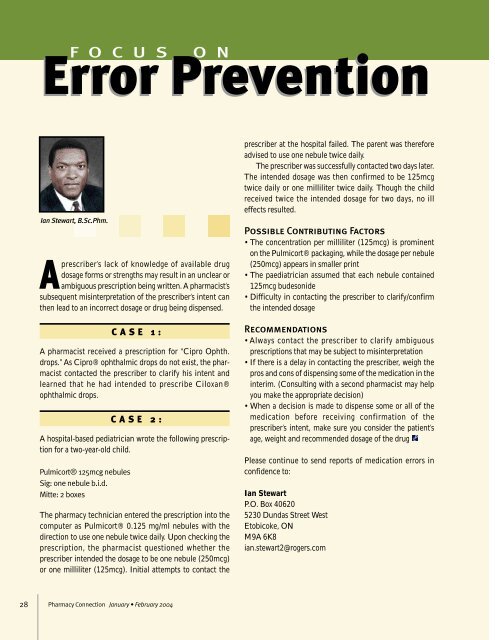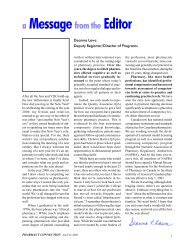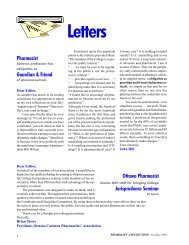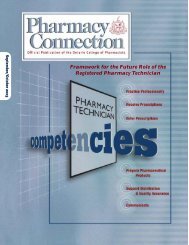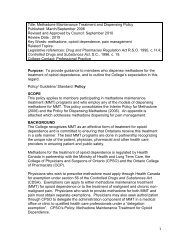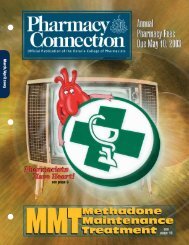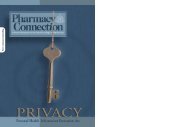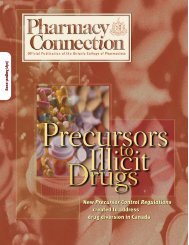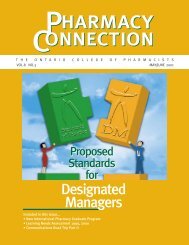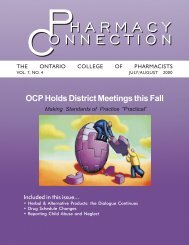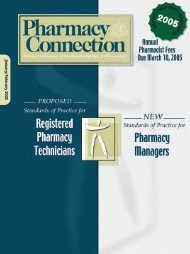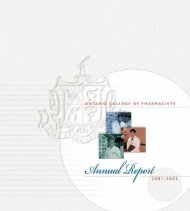January/February 2004 - Ontario College of Pharmacists
January/February 2004 - Ontario College of Pharmacists
January/February 2004 - Ontario College of Pharmacists
You also want an ePaper? Increase the reach of your titles
YUMPU automatically turns print PDFs into web optimized ePapers that Google loves.
F O C U S<br />
O N<br />
Error Prevention<br />
Ian Stewart, B.Sc.Phm.<br />
Aprescriber’s lack <strong>of</strong> knowledge <strong>of</strong> available drug<br />
dosage forms or strengths may result in an unclear or<br />
ambiguous prescription being written. A pharmacist’s<br />
subsequent misinterpretation <strong>of</strong> the prescriber’s intent can<br />
then lead to an incorrect dosage or drug being dispensed.<br />
CASE 1:<br />
A pharmacist received a prescription for “Cipro Ophth.<br />
drops.” As Cipro® ophthalmic drops do not exist, the pharmacist<br />
contacted the prescriber to clarify his intent and<br />
learned that he had intended to prescribe Ciloxan®<br />
ophthalmic drops.<br />
CASE 2:<br />
A hospital-based pediatrician wrote the following prescription<br />
for a two-year-old child.<br />
Pulmicort® 125mcg nebules<br />
Sig: one nebule b.i.d.<br />
Mitte: 2 boxes<br />
The pharmacy technician entered the prescription into the<br />
computer as Pulmicort® 0.125 mg/ml nebules with the<br />
direction to use one nebule twice daily. Upon checking the<br />
prescription, the pharmacist questioned whether the<br />
prescriber intended the dosage to be one nebule (250mcg)<br />
or one milliliter (125mcg). Initial attempts to contact the<br />
prescriber at the hospital failed. The parent was therefore<br />
advised to use one nebule twice daily.<br />
The prescriber was successfully contacted two days later.<br />
The intended dosage was then confirmed to be 125mcg<br />
twice daily or one milliliter twice daily. Though the child<br />
received twice the intended dosage for two days, no ill<br />
effects resulted.<br />
Possible Contributing Factors<br />
• The concentration per milliliter (125mcg) is prominent<br />
on the Pulmicort® packaging, while the dosage per nebule<br />
(250mcg) appears in smaller print<br />
• The paediatrician assumed that each nebule contained<br />
125mcg budesonide<br />
• Difficulty in contacting the prescriber to clarify/confirm<br />
the intended dosage<br />
Recommendations<br />
• Always contact the prescriber to clarify ambiguous<br />
prescriptions that may be subject to misinterpretation<br />
• If there is a delay in contacting the prescriber, weigh the<br />
pros and cons <strong>of</strong> dispensing some <strong>of</strong> the medication in the<br />
interim. (Consulting with a second pharmacist may help<br />
you make the appropriate decision)<br />
• When a decision is made to dispense some or all <strong>of</strong> the<br />
medication before receiving confirmation <strong>of</strong> the<br />
prescriber’s intent, make sure you consider the patient’s<br />
age, weight and recommended dosage <strong>of</strong> the drug<br />
Please continue to send reports <strong>of</strong> medication errors in<br />
confidence to:<br />
Ian Stewart<br />
P.O. Box 40620<br />
5230 Dundas Street West<br />
Etobicoke, ON<br />
M9A 6K8<br />
ian.stewart2@rogers.com<br />
28<br />
Pharmacy Connection <strong>January</strong> • <strong>February</strong> <strong>2004</strong>


